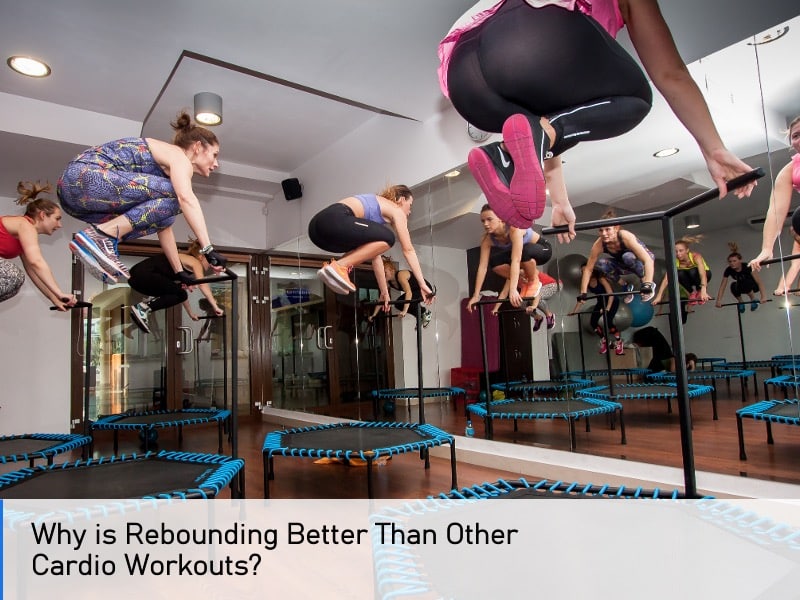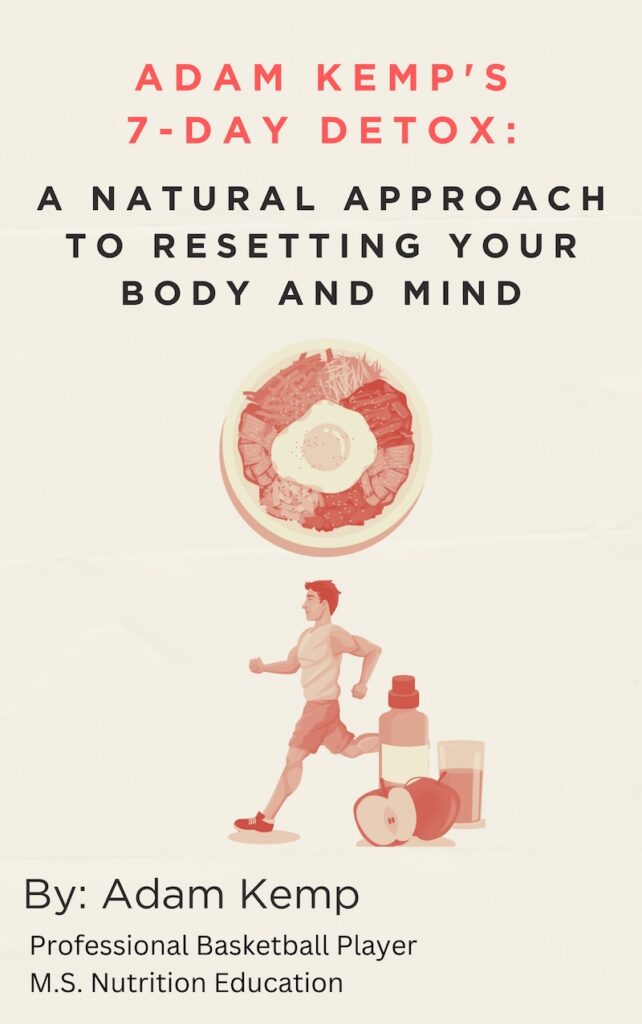Why is Rebounding Better Than Other Cardio Workouts?
If you’re wondering is rebounding better than your usual cardio workouts, you’re not alone.
Rebounding (aka jumping on a mini-trampoline) offers full-body benefits with significantly less stress on the joints than many traditional cardio workouts you’re probably used to doing.
Unlike running or high-impact interval training, rebounding supports lymphatic flow, enhances cellular energy production, and protects connective tissues, making it a compelling alternative for both seasoned athletes and beginners.
Research has demonstrated the unique benefits of rebounder trampoline exercises for years, including a 1980 NASA study that found rebounding to be up to 68% more efficient at oxygen uptake than running on a treadmill, with less impact on the body’s musculoskeletal system (Bhattacharya et al., 1980).
Modern research continues to validate its benefits.
So, is rebounding better than other cardio methods? The data strongly supports its case, especially if you value joint health, efficiency, and long-term sustainability.
Reasons Why Rebounding Outperforms Traditional Cardio Workouts
The benefits of rebounding extend far beyond what you might expect from a simple bounce. This isn’t just about getting your heart pumping; it’s about revolutionizing your entire approach to fitness.
The magic of rebounding lies in its unique ability to work with your body’s natural mechanics rather than against them.
When you bounce on a mini trampoline, you’re not just getting your heart rate up, you’re engaging in a complex dance of physics and physiology.
Low-Impact Excellence That Protects Your Joints
Traditional cardio workouts often involve pounding pavement or grinding through high-impact movements that can cause damage to your knees, hips, and ankles.
Rebounding workouts change this equation entirely.
The trampoline surface absorbs up to 87% of the impact that would otherwise jar your joints.
This means you can get an intense cardiovascular workout without the wear and tear that comes with running or jumping jacks on solid ground.
Your joints will thank you, especially if you’ve been dealing with previous injuries or are concerned about long-term joint health. It’s like having a personal shock absorber built into your workout.
Improved Lymphatic System Activation
Here’s where rebounding gets interesting.
The up-and-down motion creates a unique gravitational pull that helps stimulate your lymphatic system more effectively than traditional cardio.
This system is crucial for flushing toxins from your body and supporting immune function.
When you’re running or cycling, you’re primarily working in one plane of motion, but leaps and rebounds engage your entire body in a more dynamic, three-dimensional way.
This full-body movement is what makes rebounding so effective for improving overall health.
Your body reacts to the constant shifts in force by activating muscles you might not even realize you’re using. It’s a low-impact workout with high-impact benefits.
Superior Calorie Burn in Less Time
Traditional cardio often requires lengthy sessions to see meaningful results.
You might spend 45 minutes on a treadmill and feel like you’ve barely scratched the surface.
With rebounding, you can work up a massive sweat in just 30 minutes while burning calories at an accelerated rate. The constant muscle engagement required to maintain balance and control amplifies your energy expenditure.
The beauty lies in efficiency.
You’re not just moving your legs like you would while running, you’re engaging your core, arms, and stabilizing muscles throughout the entire session.
Improved Cardiovascular Health with Reduced Risk
Rebounding vs traditional cardio reveals some surprising advantages for heart health.
As an aerobic exercise, rebounding can also help reduce the risk of heart disease, stroke, and other cardiovascular problems without the stress that high-impact activities place on the heart.
This makes it particularly valuable for older adults or those recovering from cardiac events who need effective exercise options that won’t overwhelm their system.
Better Coordination and Balance
Traditional cardio exercises, such as running or cycling, follow predictable patterns.
Your body adapts quickly, and the neurological challenge diminishes over time.
Rebounding constantly challenges your proprioception, your body’s ability to sense its position in space.
Every bounce requires micro-adjustments that improve your coordination and balance.
These improvements translate to improved performance in daily activities and a reduced risk of falls as you age.
The versatility of rebounding makes it an ideal choice for individuals seeking effective cardio workout alternatives that cater to various fitness levels and goals.
Practical Implementation: How to Add Rebounding to Your Routine
Getting started with rebounding doesn’t require a complete lifestyle overhaul.
The beauty of this exercise form lies in its accessibility and adaptability to different fitness levels and schedules.
Equipment and Space Requirements
You don’t need a massive home gym or expensive equipment to start reaping the benefits of rebounding exercise.
A quality mini trampoline takes up minimal space and can be easily stored when not in use.
Most rebounders are about 40 inches in diameter, which is smaller than most coffee tables.
The investment is relatively modest compared to treadmills or elliptical machines, making it an attractive option for home fitness enthusiasts.
You can set up anywhere with about 8 feet of ceiling clearance and enough room to move your arms freely.
Beginner-Friendly Progression
Starting with basic bouncing motions, you can gradually incorporate more complex movements as your confidence and skills develop.
- Begin with gentle bounces where your feet barely leave the surface, focusing on finding your rhythm and balance.
- As you progress, you can add arm movements, increase bounce height, or incorporate dance-like sequences.
The learning curve is gentle, making it accessible for people who might feel intimidated by traditional gym equipment or high-intensity classes.
Workout Customization Options
One of the greatest advantages is the ability to customize your workout intensity.
Want a gentle recovery session?
Keep your bounces low and controlled.
Need to burn off stress after a tough day?
Increase the intensity and add explosive movements.
The same piece of equipment can provide vastly different workout experiences depending on your needs and energy levels.
This flexibility makes rebounding sustainable as a long-term fitness solution, adapting to your changing needs and preferences over time.
The growing popularity of rebounding reflects broader shifts in how we approach fitness and wellness in our daily lives.
How Rebounding Integrates with Technological Advancements
As fitness trends come and go, rebounding has demonstrated remarkable staying power.
The resounding trend is that at-home workouts are here to stay, and rebounding fits perfectly into this paradigm shift.
Home Fitness Integration
The pandemic accelerated a movement toward home-based fitness that shows no signs of slowing down.
People have discovered the convenience and privacy of working out at home, and rebounding delivers professional-quality results without requiring a gym membership or the time spent commuting.
The compact nature of rebounders makes them ideal for apartment living and busy schedules.
You can squeeze in a quick 15-minute session before work or during your lunch break without needing to change clothes or leave home.
Technology Integration and Virtual Classes
Modern rebounding has embraced technology, with online classes and apps providing guided workouts for all skill levels.
This combination of traditional exercise with digital convenience appeals to contemporary individuals who want variety and professional instruction without the constraints of scheduled classes.
The social aspect hasn’t been lost either, virtual rebounding communities allow people to share their experiences and stay motivated together, even when bouncing solo at home.
Sustainable Fitness Solution
Unlike high-impact activities that might become unsustainable due to injury or wear, rebounding can be a lifelong fitness companion.
The low-impact nature means you can continue reaping benefits well into your golden years, making it a wise investment in long-term health and mobility.
This sustainability factor is increasingly important as people seek exercise options that will serve them throughout different life stages and physical capabilities.
Final Thoughts: Why is Rebounding Better?
If you’re still wondering, “Is rebounding better than running, biking, or HIIT?” the science and real-world results speak volumes.
Rebounding offers an unmatched combination of joint protection, cardiovascular efficiency, and full-body engagement, all wrapped in a workout that actually feels fun.
It’s approachable for beginners, sustainable for older adults, and dynamic enough to challenge even seasoned athletes.
Unlike many forms of cardio that break you down over time, rebounding builds you up physically, mentally, and even emotionally.
So, is rebounding better?
For anyone seeking an enjoyable, efficient, and joint-friendly fitness solution, it’s not just better, it’s a bounce in the right direction!
Frequently Asked Questions About Rebounding
This website does not provide medical advice. This website site does contain affiliate links, and purchases may earn a commission.
Read my Medical Disclaimer, Review Disclaimer, and Publishing Policies for more details. Use of this site indicates acceptance of these terms.



